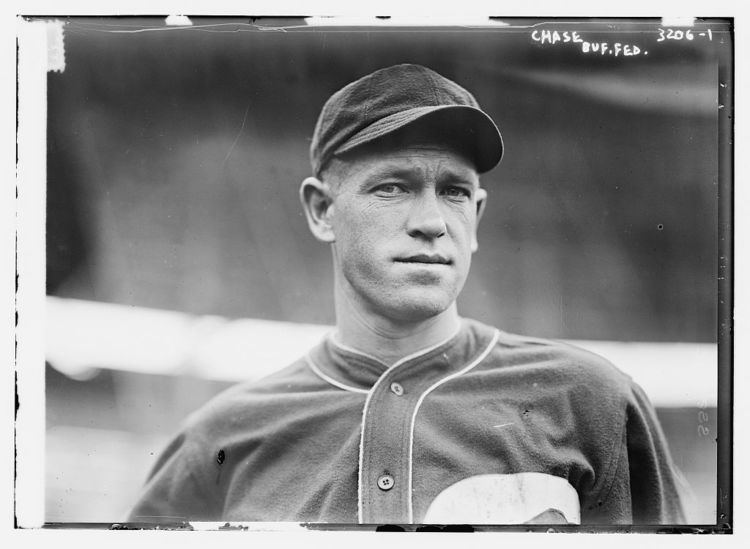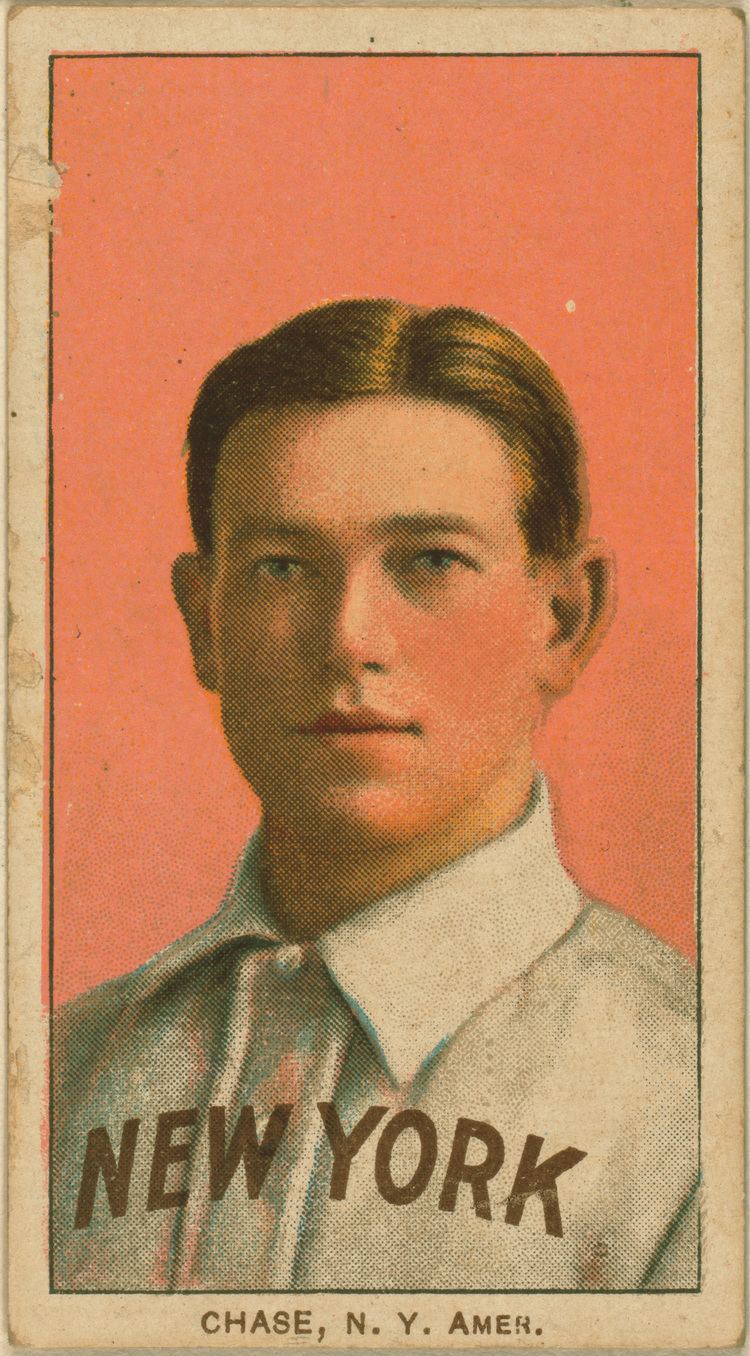Batting average .291 Runs batted in 941 Name Hal Chase Education Santa Clara University | Home runs 57 Stolen bases 363 Role Baseball player | |
 | ||
Died May 18, 1947, Colusa, California, United States | ||
Hal chase professional ball player
Harold Homer Chase (February 13, 1883 – May 18, 1947), nicknamed "Prince Hal", was a first baseman in Major League Baseball, widely viewed as the best fielder at his position. During his career, he played for the New York Highlanders (1905–1913), Chicago White Sox (1913–1914), Buffalo Blues (1914–1915), Cincinnati Reds (1916–1918), and New York Giants (1919).
Contents
- Hal chase professional ball player
- Hal Chase The Real Story from a Man Who Played with him NY Highlanders
- Career
- Corruption
- Out of organized baseball
- Chase defensively
- References
No lesser figures than Babe Ruth and Walter Johnson named Chase the best first baseman ever, and contemporary reports described his glovework as outstanding. He is sometimes considered the first true star of the franchise that would eventually become the New York Yankees. In 1981, 62 years after his last major league game, baseball historians Lawrence Ritter and Donald Honig included him in their book The 100 Greatest Baseball Players of All Time.

Despite being an excellent hitter and his reputation as a peerless defensive player, Chase's legacy was tainted by a litany of corruption. He allegedly gambled on baseball games, and also engaged in suspicious play in order to throw games in which he played.
Hal Chase - The Real Story from a Man Who Played with him. NY Highlanders
Career

Chase attended Santa Clara College, where he played baseball. He signed his first contract with the Los Angeles Angels of the Class-A Pacific Coast League in 1904. The New York Highlanders selected Chase from Los Angeles in the 1904 Rule 5 draft on October 4, 1904.

Chase joined the Highlanders in 1905, and held out during March 1907, threatening to sign with the outlaw California League if the Highlanders did not increase his salary. Though he agreed to join the Highlanders in April 1907, he also insisted on playing in the California League during the winter. After the Highlanders fired manager Clark Griffith during the 1908 season, Chase held out and insisted he would not play for new manager Kid Elberfeld.

Chase served as player–manager in 1910 and 1911. He signed a three-year contract with the Yankees before the 1913 season, but they traded him to the Chicago White Sox for Babe Borton and Rollie Zeider on June 1, 1913. Before the 1914 season, Chase jumped from the White Sox to the Buffalo Blues of the Federal League.
Following a spell in the short-lived Federal League, he went to the Reds. In 1916, Chase led the NL with a .339 batting average. After Buck Herzog was fired as Reds manager in 1917, Chase was again passed over for management in favor of Christy Mathewson.
On February 19, 1919, the Reds traded Chase to the New York Giants for Walter Holke and Bill Rariden. It has long been rumored that the Giants acquired him after Mathewson let it be known he wanted nothing to do with Chase. However, this story is belied by the fact that Mathewson signed on with the Giants (where he had starred for many years as a pitcher) as assistant manager to John McGraw; moreover, after McGraw took a leave of absence from the team near the end of the 1919 season, Mathewson named Chase as first base coach.
Corruption
Chase faced allegations of wrongdoing as early as 1910, when his manager, George Stallings, claimed that Chase was "laying down" in games. This claim was later made by Stallings' successor as manager of the Highlanders, Frank Chance.
On May 29, 1913 Chance accused Chase of throwing games. He benched Chase, who was batting .212, vowing never to play him again. On June 1, the Yankees announced that Chase had been traded to the Chicago White Sox for two infielders of modest abilities, Rollie Zeider and Babe Borton.
Midway through the 1918 season, Chase allegedly paid pitcher Jimmy Ring $50 ($787 today) to throw a game against the Giants. Mathewson got wind of it and suspended Chase for the rest of the season. Mathewson brought formal charges against Chase for fixing games, but National League president John Heydler acquitted him. Heydler had told sportswriter Fred Lieb in private that he believed Chase had bet on baseball, but did not have enough evidence to convict him.
After the end of the season, an unknown individual sent Heydler a copy of a $500 ($6,824 today) check that Chase received from a gambler for throwing a game in 1918 — the same year that he had acquitted Chase for throwing games. Armed with this evidence, Heydler ordered Giants owner Charles Stoneham to release Chase. Since no American League team would sign him (on the advice of Detroit Tigers manager Hughie Jennings), Chase was now effectively blackballed from the major leagues.
Out of organized baseball
Rumors of him being the middleman between the players and the gamblers in the Black Sox Scandal have never been confirmed. A Chicago grand jury indicted him for his role in the scandal, but California refused extradition because of an incorrectly issued arrest warrant. However, he did acknowledge having advance knowledge of the conspiracy, saying he "was no squealer".
In 1920, while playing for the minor Mission League, he attempted to bribe Spider Baum, a pitcher for the Salt Lake Bees of the Pacific Coast League, to lose a game to the Los Angeles Angels. He also allegedly bribed an umpire. It turned out to be one of the last games he played in organized baseball. In the aftermath of the Black Sox Scandal, newly appointed Commissioner of Baseball Kenesaw Mountain Landis declared no player who threw a game or promised to throw a game would ever be allowed in baseball—effectively ending any realistic chance of Chase returning to the majors.
For a time, Chase was player-manager of an outlaw team in Douglas, Arizona that included Buck Weaver, Chick Gandil and Lefty Williams. It was part of a league run by S.L.A. Marshall, who later said that Chase admitted to throwing a game. A few months later, he tore both Achilles tendons in a car accident. He later drifted to Mexico, where in 1925 he began making plans to organize a professional league. When American League president Ban Johnson got word of it, however, he pressured Mexican authorities to deport Chase.
Despite his unsavory past, Chase received a certain amount of National Baseball Hall of Fame support early in its history. During the inaugural Hall of Fame balloting of 1936, Chase garnered 11 votes and was named on 4.9% of the ballots. This total was more votes than 18 future Hall of Famers including such greats as Connie Mack, Rube Marquard, Mordecai "Three Finger" Brown, Charlie Gehringer, and John McGraw as well as the banned Shoeless Joe Jackson. In 1937, he received 18 votes (9%) which was more than 32 future Hall of Famers. Chase was dropped from the ballot following the 1937 vote. He never received the 75 percent support required for enshrinement, largely due to an informal agreement among the Hall of Fame voters that those deemed to have been banned from baseball should be ineligible for consideration.
Chase spent the rest of his life drifting between Arizona and his native California, working numerous low-paying jobs. Later in life, he expressed considerable remorse for betting on baseball. He lived with his sister in Williams, California and died in a Colusa, California hospital at the age of 64.
Chase defensively
In his day, Hal Chase was almost universally considered one of the best fielders in the game — not just at first base, but at any position, even compared to catchers and middle infielders. In his Historical Baseball Abstract, Bill James quotes a poem entitled "You Can't Escape 'Em":
Sometimes a raw recruit in spring is not a pitching find;
He has not Walter Johnson's wing, nor Matty's wonderous mind.
He does not act like Harold Chase upon the fielding job,
But you may find in such a case, he hits like Tyrus Cobb.
Douglas Dewey and Nicholas Acocella's book on Chase, The Black Prince Of Baseball, talks about Chase's defensive abilities at length. He apparently made many spectacular plays that burnished his reputation as a glove wizard, but also committed 402 errors at first in just ten seasons, making his career fielding average only .980, four points below average for the period (since Chase was known to throw games, it's impossible to know how many of these misplays were intentional).
A more recent work by Bill James, Win Shares, suggested Chase was only a C-grade defensive player at first base. Analyst Sean Smith says on the Baseball-Reference.com website that Chase was below average defensively, costing his teams 65 runs versus an average first baseman.
